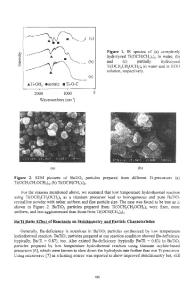Preparation of New Bismuth Oxides by Hydrothermal Reaction
- PDF / 433,478 Bytes
- 6 Pages / 595 x 842 pts (A4) Page_size
- 107 Downloads / 305 Views
Preparation of New Bismuth Oxides by Hydrothermal Reaction N. Kumada, T.Takei, N. Kinomura and A. W. Sleight1 Faculty of Engineering, Yamanashi University, Miyamae-cho 7, Kofu 400-8511 Japan, 1 Department of Chemistry, Oregon State University, Corvallis, OR 97331, USA
ABSTRACT Hydrothermal reactions using NaBiO3·nH2O produced a variety of new bismuth oxides that were not prepared by high temperature reaction. Some of them have pentavalent bismuth such as Bi2O4, LiBiO3, ABi2O6 (A = Mg, Zn) and AgBiO3. When using transition metal or rare-earth metal solutions, new bismuth oxides with trivalent bismuth were obtained. In the case of Cr(NO3)3 solution a chromium bismuth oxyhydroxide, HBi3(CrO4)2O3, was prepared at 180ºC, while in A2CrO4 (A = Li, Na, K) solution a new bismuth chromium oxide, Bi8(CrO4)O11, was prepared above 180ºC. When A2MoO4 (A = Li, Na, K) solution was used, a new phase appeared above 220ºC. By using A2WO4 (A = Li, Na, K) solution β-Bi2O3 and Bi2WO6 were obtained above 220ºC. INTRODUCTION We have reported several new bismuth oxides prepared by hydrothermal reaction using hydrated sodium bismuth oxide, NaBiO3·nH2O as a starting material [1-12]. Table 1 summarizes new bismuth oxides prepared by hydrothermal reaction with NaBiO3·nH2O. Some of them have pentavalent bismuth such as Bi2O4 with the β-Sb2O4-type structure [6], LiBiO3 with the LiSbO3-related structure [7], ABi2O6 (A = Mg, Zn) with the trirutile-type structure [8] and AgBiO3 with the ilmenite-type structure [10]. One of them, Bi2O4 is the first example of a mixed valent bismuth oxide with distinct crystallographic sites of Bi3+ and Bi5+. These bismuth oxides with Bi5+ cannot be prepared by usual high temperature reaction. In the course of this investigation we attempted hydrothermal reaction with NaBiO3·nH2O in A2MO4 (A = Li, Na, K; M = Mo, W) solution. In this paper, we will review the crystal structures of bismuth oxides prepared by hydrothermal reaction with NaBiO3·nH2O and report the latest results from these reactions.
Table I. Products of hydrothermal reaction with NaBiO3·nH2O. Solution LiOH AOH (A = Li, Na, K) AOH (A = Li, Na, K) KOH ANO3 (A = Li, Na, K) A(NO3)2 (A = Ca, Sr, Ba) AgNO3 A(NO3)2 (A = Mg, Zn) Ln(NO3)2 (Ln = La, Nd) Ln(NO3)2 (Ln = Y, Sm, Eu, Gd, Tb, Dy, Er, Yb) Cr(NO3)3 A2CrO4 (A = Li, Na, K)
Reaction Temp. (ºC) 120 120~160 160~190 200 120~160 180 70 90~130 180 140~200
Product LiBiO3 Pyrochlore Type Bi4O7 New allotropic Bi2O3 Bi2O4 Pyrochlore Type AgBiO3 ABi2O6 (Ln,Bi)OOH (Ln,Bi)3O4NO3
Ref. [7] [2] [5] [10] [6] [1] [11] [8] [3] [9]
180 180~220
HBi3(CrO4)2O3 Bi8(CrO4)O11
[4] [12]
EXPERIMENTAL The starting material (1 g) of NaBiO3·nH2O (Nacalai Tesque Inc.) was put into an autoclave (70 mL) with a teflon lining with various solutions (30 mL). The reaction temperature was 70~260ºC and the reaction duration was 4~7 days. The solid products were separated by centrifuging, washed with distilled water and dried at 50ºC. The products were identified using an X-ray powder diffractometer with CuKα radiation. The thermal stabilit
Data Loading...











